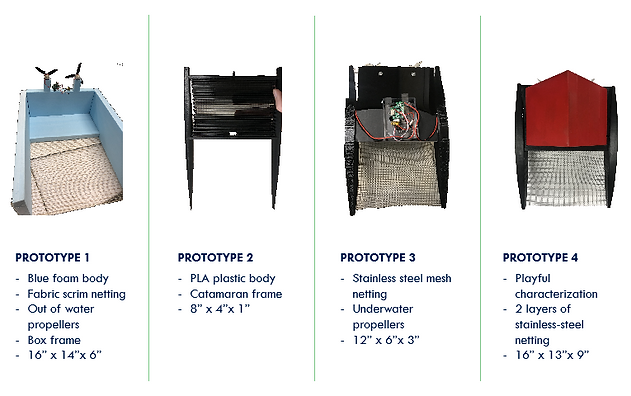project description: develop an intervention with physical touchpoints to mitigate a systemic material waste problem.
project description: develop an intervention with physical touchpoints to mitigate a systemic material waste problem.
Elizabeth Price
engineer | designer |
trash packer
a remote-controlled water trash collector
collaborative design engineering studio | MDE - Harvard GSD
project description: develop a physical product which will prototype a radical approach to waste. Consider pre-consumer or post-consumer waste, or the rehabilitation of waste environments.
contribution: user research, physical prototyping, product research
team member: Cate Tompkins
design goal: to design an educational and interactive tool that empowers the community to take action against the growing issue of microplastics in public waterways.
learning outcomes: iterative design, physical prototyping, reality capture, product animation/ rendering
tools & processes: adobe photoshop, illustrator, rihno, 3D printing, keyshot, physical prototying
problem
80% of trash that ends up in the ocean comes from land sources. This is due to either wind sweeping the trash into bodies of water, from people littering and runoff from storms carrying the trash into the water, or through the inadequate filtration of microplastics from households and industries. The problem is that there is a lack of ownership over this issue and a lack of awareness among the public.
process
Through a locally-focused intervention, we aim to design a product that allows the public to take ownership of the waste problem that they're both contributing to and suffering from. Furthermore, we hope our product paves the way for further action on the part of the public and larger governing bodies with regards to facing and better addressing the issue of trash, specifically plastic, in waterways.
solution
We propose a small-scale intervention designed specifically for the purpose of educating children about the waste problem, and enabling the public to participate in the river clean-up effort. Second, propose introducing our product within the educational aspect of the Science Museum in Boston, MA to optimize the awareness aspect of the problem by combining it with a very informational and academically-supported exhibit.

opportunity analysis
the problem




the system
single-use plastic usually ends up in the landfill or recycling sytem after disposal by the user; however, there are multiple cases in which the plastic ends up in various water ways which only leads to harmful environmental consequences
research question
how can we clean up the river and prevent further plastic pollution in the ocean?

hypothesis
a remote control trash collector designed to be used by kids in conjunction with the Museum of Science can empower kids to clean up the river & increase public awareness of the problem and alternative solutions to plastic pollution

our solution
the product



functionality
in order for our product to best be used to not just inform users about waste, but allow them to make a tangible impact, we chose to gamify our product by implementing it as a collection of robots that compete against each other despite working towards the same goal.
user journey
we believe that our product will be be able to seamlessly integrate into the current interactive and family-friendly atmosphere of the Museum of Science, allowing users to learn from the trash packer exhibit as they would any other museum attraction.

research
stakeholder interviews





functional & form design
to optimize the functionality of our product, we researched everything from the material of our device to the boat body and electrical configuration in order to ensure that the trash packers would be up to the task of traversing the Charles River.



design & development
design principles
knowing that our product would be used on natural rivers during various weather conditions, we wanted to ensure that it would hold up and still perform at its optimal ability, so we prioritized the durability of the device. Additionally, having designed the trash packer intending for the end user to be a child, we wanted to ensure that our product was child-friendly (fun and easy to control) simple (individual scale and attractive), and engaging (exciting, noticeable, and gamified).


prototyping
our physical prototype went through multiple stages as we continuously improved our understanding of buoyancy and boat design, and worked towards implementing our ideal product materials. By the end of our product development process we had reached our preferred building scale and implemented the characterization of the product that would hopefully solidify the engagement factor with the children users.



impact












